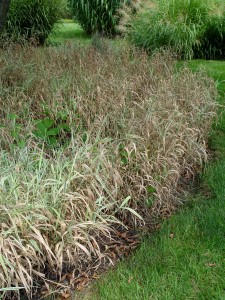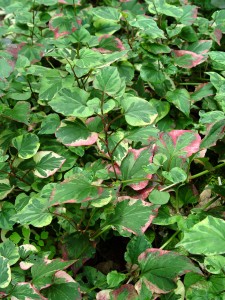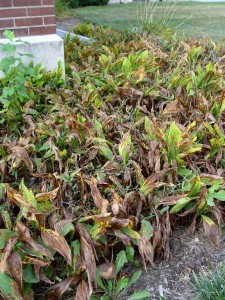Bottom 10 Perennials
September 24th, 2013
Last week I told you about the 10 annual flowers that rate at the bottom of my “would-plant-again” list.
This week it’s perennials’ turn.
Remember, I’m not saying you should never plant any of these, and it doesn’t mean I hate them. (OK, maybe it does in some cases.)
These are ones I’ve had no luck with and/or that, in my mind, have at least one serious drawback.
Fire away with your own non-favorites by using the comment button below.
Here are my Bottom 10 Perennials for central Pennsylvania:
1.) Ribbongrass (Phalaris). I’m still traumatized by my early-years experience of putting this neighbor pass-along grass into a perennial garden. It didn’t run everywhere, it sprinted. It’s the Usain Bolt of invasive grass plants. Don’t be fooled by the enticing variegated coloration. It took me years to get rid of it…
2.) Bishop’s weed (Aegopodium). It’s probably a good idea to think twice about any plant that has “weed” in the name. This one is also prettily variegated but overly aggressive in any situation other than in its own mass planting in a dry-shade, root-competition setting… if even there.
3.) Chameleon plant (Houttuynnia). This tri-colored creeper completes the invasive trifecta. Once again, very alluring in a pot, but it sprints faster than you can rein it in. It’s fine contained in a pot in a water garden, but on land, stay on top of it or be sorry.
4.) Yellow archangel (Lamiastrum). OK, make that four creeping invaders to avoid. This lamium relative has little yellow flowers and creamy-white variegated leaves, but it overtakes most any neighbor. By itself on a shady, rocky bank, yellow archangel is a decent alternative to ivy. Otherwise, I’d like to see who wins in a cage match of ribbongrass, bishop’s weed, chameleon plant and yellow archangel.
5.) Prickly pear cactus (Opuntia). This short, spreading, thorny native turns weeding into painful torture. I planted it once and liked the yellow flowers, but no matter how careful I was working in and around that bed, I was constantly getting bloodied by the dratted spines. I don’t need plants that fight back. The bugs and animals are bad enough.
6.) Lily-of-the-valley (Convallaria). Lily-of-the-valley makes a cute shady groundcover when the leaves are fresh in spring and the white, bell-shaped flowers are hanging all over. Check back by mid-summer, though, and leaf-spot and rust diseases have turned the patch into a sickly brown mess from then on. The plants usually grow back like nothing happened the following spring, but they look horrid for far longer each year than they look good.
7.) Hollyhock (Alcea). Maybe this doesn’t happen to you or your variety, but every time I’ve tried growing old-fashioned hollyhocks from seed or transplant, they’re devastated by leaf-ruining rust disease just as they’re hitting prime bloom time. They’re big and showy in bloom, but also big and showy in ruin.
8.) Jacob’s ladder (Polemonium). Few plants grab your eye faster in a garden center than the variegated forms of this shade perennial with the laddered leaves. I can’t get any to go longer than one season. I’m not sure what gets them first – wet winter soil or voles. Either way, I view at least variegated Jacob’s ladder as a $10 or $12 annual. No thanks.
9.) Monkshood (Aconitum). Those hooded blue-purple bloomers are striking late in the season, but this is one of the most toxic plants. I’m not planning on eating it, but like castor beans and datura, it crosses my comfort-zone line. I’m not terribly keen on plants that can kill.
10.) Pink evening primrose (Oenothera speciosa). Some people really like this tall, pink, wispy bloomer because it spreads and comes back with ironclad will each year. To my eye, they look gangly even at their peak. They bloom only late in the day when in flower, look weedy to me the rest of the season after they go out of flower, and they often seed where you don’t want them (definition of a weed). Sorry, I just don’t care for them.
I could keep going on with this list, but I’ll just say that Jupiter’s beard dies out in two or three years; scabiosa often rots in wet soil over winter; gooseneck loosestrife is too loose and causes strife; bugleweed creeps into the lawn if you don’t watch it, and lupines and delphiniums are true beauties that just can’t handle our summer heat.
To see what perennials I DO like, check out the perennials section of my Plant Profiles page.
And see my list of Bottom 10 Annuals and my list of Bottom 10 Shrubs.










